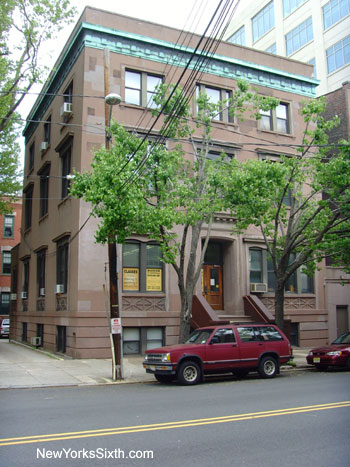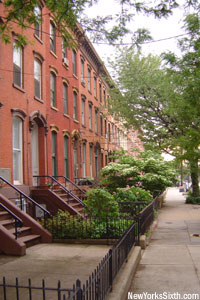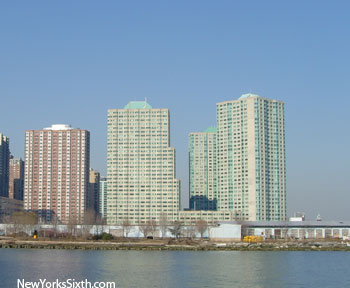Parking on the streets of Jersey City can be a confusing adventure for residents and visitors alike. There are a multitude of signs, restrictions and prohibitions. This guide covers Zone Parking, Street Cleaning, Snow Emergency Routes, and Police Emergencies.
2 Hour Parking Except With Zone Permit

Throughout the residential neighborhoods of Jersey City, Zone Parking has been instituted to prevent drivers from outside the community from parking on the streets and commuting into Manhattan providing parking availability to local residents. The downtown area of Jersey City is divided into a number of smaller zones. Residents within the zone can purchase a resident decal from the Jersey City Parking Authority. All other vehicles without a zone decal are subject to ticketing, booting and towing. Time limits posted on the signs indicate the duration a vehicle may be parked on the street before the parking authority will issue a ticket.
The 2 and in some cases 4 hour limits are imposed on all vehicles without zone permits. This limit includes vehicles owned by local residents if the vehicle does not have a zone permit. The Jersey City parking authority patrols the streets daily in small three wheeled vehicles. Time limits are for zones—not parking spaces. If a driver moves his or her car within the zone, the vehicle is still subject to the time limit.
Residents can apply for and purchase zone decals from the Jersey City Parking Authority located at 394 Central Avenue in the Heights district of Jersey City. Resident permits cost $10 per year and will only be issued to residents without outstanding parking tickets. The parking authority does not accept credit cards. For residents who have previously bounced a check written to the Parking Authority, a bank check is required.
In addition, residents must provide a driver’s license, vehicle registration, and insurance card with their Jersey City address. Part-time residents, students, or other persons who for some reason do not have a qualifying Jersey City address on their driver’s license and matching vehicle registration will be denied a permit. In addition, leased vehicles registered to a company outside of Jersey City are also not eligible. Drivers of leased vehicles should call the parking authority directly regarding the necessary steps to ensure they receive a permit on the first round 201.653.6969.
New residents may provide a PSEG bill and signed lease for proof of residency, though in many cases will receive only a temporary parking permit. The Parking Authority is one of the most temperamental government agencies of the city.
Be Prepared Before You GoYou need to have / provide:
Driver’s License
Vehicle Registration
Insurance Card
$10 Check
View the
Parking Zone MapNo Parking Between the hours of...

Most streets in Jersey City have a two hour block of time twice a week, usually between Monday and Friday that is used for street cleaning. The Jersey City Incinerator Authority is in charge of cleaning the streets with a street sweeping machine. However, the JCUIA works in conjunction with the Parking Authority. The Parking Authority scooters travel ahead of the street sweeping machine writing tickets.
In some cases, the Parking Authority scooter will honk a distinctive horn alerting residents that they are on their way down a street for cleaning. However, the horn is certainly not a guarantee, and the best way to avoid a ticket is simply to move a car off the side of the street before the specified block of time.
Residents with permits will get tickets. Zone permits have nothing to do with street cleaning and zone permits do not exempt vehicles.
On most federal holidays or city holidays, the incinerator authority is usually not in operation. However, to ensure that street cleaning is suspended, drivers should call the authority directly on any given day 201.432.1150.
Emergency Snow Route
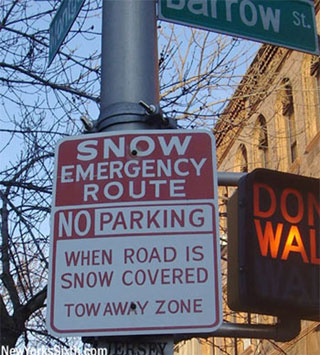
Some streets throughout the city are marked with red and white signs declaring the street a snow emergency route. These streets are given priority for snow removal—a good tip to know if you absolutely need to drive somewhere in a heavy snowstorm.
Snow emergencies are declared by the city. Usually, after a snow emergency is declared, the police or fire department will announce over loudspeakers that cars on particular streets need to be removed by a certain time. Vehicles that are not moved will be towed. However, it should be assumed that anytime the road is covered with enough snow for a plow, vehicles parked along emergency snow routes should be removed.
In addition, after heavy snowstorms, some streets may have parking restrictions for further snow removal. This is to ensure that main arteries do not become narrow after plows have pushed snow against parked cars.
Several inches of snow are normally required for snow removal crews to use snowplows. Light snow that is easily removed with salt will not usually result in a snow emergency.
Police Emergency
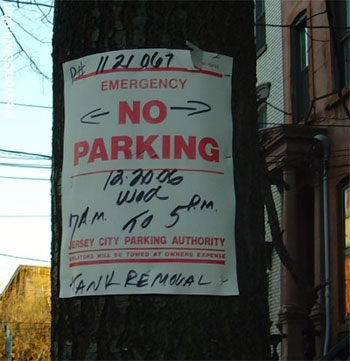
From time to time, streets will have posted specialty "No Parking" signs specifying a date and time when parking is prohibited. There are a number of uses when police emergency signs are posted including parades, construction or utility work, or special permits issued by the city. These restrictions often start before scheduled street cleaning, often as early as six or seven in the morning. Read these signs carefully as they are enforced most often with straight up towing.
Parade season begins mid-spring and continues through much of the summer. There are often parades at least one day per weekend in the spring and summer, though they take different routes and do not always require parking to be prohibited. These signs are also used from time to time for snow removal, which obviously is a winter only event. During the 2006 blizzard, an overnight parking prohibition was used to clear snow from certain streets.
In most cases, the "No Parking" signs will be placed every ten to twenty feet twenty-four to thirty-six hours before a scheduled street closing. However, there certainly have been cases when the city has forgotten to issue the "No Parking" permits ahead of time, and hours or even minutes before an event, post "No Parking" signs.
Disclaimer: Drivers should read all signs before parking. We are not responsible for any parking ticket you receive.
Labels: Guide



